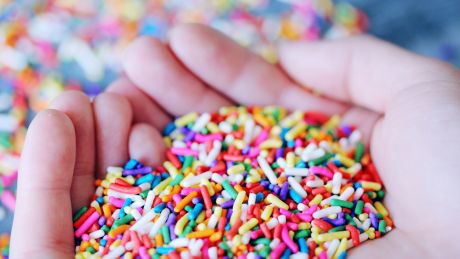How Much Sugar Should You Have A Day?
Fair warning, this gets complicated – but keeping tabs on your sugar intake will help avoid piling on the pounds

If you want to maintain a healthy weight, it’s a good idea to limit the amount of sugar you eat, and if you want to lose weight, it’s a great idea to limit the amount of sugar you eat. That bit is simple. Cutting down on sugar, however, isn’t as simple as drinking your tea without it (although that is an excellent place to start), because the sweet stuff is found in abundance in all kinds of foods. Some of those are obvious – you all know that fizzy drinks and cakes are high in sugar, right? – and some are less so, with savoury shop-bought sauces and ready meals often containing surprisingly large amounts of sugar.
To make sure your sugar intake isn’t going overboard, you need to do a couple of things. One is to work out roughly how much you should be eating, and the second is to start scanning labels carefully to ensure sugar isn’t sneaking into your diet in unexpected ways. For advice on both of those, we spoke to dietitian Aisling Pigott of the British Dietetic Association.
What is the recommended amount of added sugar people should have each day?
There’s no absolute amount of sugar that’s recommended for everyone. You need to work out how it relates to the overall amount of calories you consume each day.
“Ideally, less than 5% of our calorie intake should come from added or ‘free’ sugar,” says Pigott. “So for example, for an average – and I use that term loosely, because we are all very different – woman requiring 2,000 calories, this would equate to 25g of free sugar.”
What is an added sugar?
“This refers to sugars removed from the original source,” says Pigott. “For example, fruit doesn’t count as added sugar when it’s in its whole from, but fruit syrup would count. Sometimes this can get confusing for products containing milk or fruit because some of the sugar will be naturally occurring and does not need to be limited. I always suggest that people check the sugar content, then follow it up by checking the ingredients for milk and sugar to make an informed decision.”
Yogurt is one product that can demonstrate this confusion, in that it contains milk sugars but also often free sugars. Charity Diabetes UK has some handy information on working out how much added sugar is in a yogurt: as a rough guide, the first 5g of sugars in 100g of yogurt is generally milk sugars; beyond that, it’s likely to be added sugars.
When checking an ingredient list, it’s worth knowing that these are listed in order of the quantity present. So if sugar (or something like fructose, dextrose or glucose) is listed in the top three ingredients, it’s safe to assume that it’s got a lot of sugar in it.
Sign up for workout ideas, training advice, reviews of the latest gear and more.
To apply this to milk, standard whole milk contains around 5g of sugar per 100ml, but chocolate milk has around 9g-10g per 100ml, and sugar comes in at second in the ingredient list. That’s an indication that there’s a significant amount of free sugar present.
When figuring out how much sugar you can eat a day, is there any difference between white sugar, brown sugar, honey and syrups?
“Unfortunately sugar is sugar and all of these sources should be consumed in moderation,” says Pigott. Alternative sugar sources might also contain some other nutrients, but the sugar counts towards your added sugar intake just the same.
- To find out more about those other nutrients in honey, we asked a dietitian, is honey good for you?
Which common foods are surprisingly high in sugar?
Thankfully, this bit is simple. Sugar is in everything.
“Biscuits, some breads, beans, cereal, ready meals – the list goes on,” says Pigott. “Generally anything which has been processed may have sugar added, so do check!”
What should people look out for on a label to tell if a product is high in sugar?
“Anything with more than 20g sugar per 100g is a high-sugar food,” says Pigott.
This is really the key thing to check, because it’s easy to be misled by serving sizes and other label shenanigans. Even the traffic light system on the front of packs isn’t a foolproof guide because, as Pigott explains, it “isn’t legally binding and standards across suppliers and products differ.”
We realise that’s a lot on to take on, so here’s the simple version. Work out how much 5% of your daily calories is and start checking food labels closely, including a scan of the ingredients list. Oh, and stop putting sugar in your tea.

Nick Harris-Fry is a journalist who has been covering health and fitness since 2015. Nick is an avid runner, covering 70-110km a week, which gives him ample opportunity to test a wide range of running shoes and running gear. He is also the chief tester for fitness trackers and running watches, treadmills and exercise bikes, and workout headphones.
